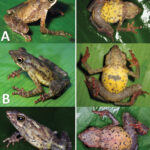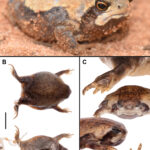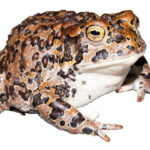Atelopus loettersi: Exploring the Enigmatic Jewel of the Andes#
In the mist-shrouded forests of South America’s Eastern Andes thrives an extraordinary creature, largely hidden from public view yet captivating those fortunate enough to encounter its distinctive charm. The Harlequin Toad species known scientifically as Atelopus loettersi is a dazzling amphibian that perfectly exemplifies nature’s artistry and biological intrigue.
Marked by vibrant patterns, remarkable behaviors, and a precarious existence, Atelopus loettersi represents much more than its striking appearance suggests. Beyond being a colorful resident of remote rainforest streams, it symbolizes a delicate ecological balance, warning us of the hidden costs of environmental upheaval. Among biologists and conservationists, it holds both fascination and urgency—embodying biodiversity’s fragility and resilience.
Taxonomy and Classification#
Atelopus loettersi belongs to the Bufonidae family, grouped within the iconic genus Atelopus—commonly known as Harlequin Toads or Jewelled Toads. Members of this genus typically exhibit striking aposematic (warning) coloration, indicating to would-be predators their toxic defenses. Paradoxically elegant in appearance yet powerfully toxic, these toads have evolved intricate relationships with their ecosystems.
Described formally by De la Riva, Castroviejo-Fisher, and Chaparro in 2011, Atelopus loettersi was named in honor of Stefan Lötters, an influential herpetologist distinguished by his extensive contributions to our understanding of neotropical amphibians and conservation. Closely related species within this genus, such as Atelopus peruensis and Atelopus erythropus, share many similar ecological and morphological traits yet each displays distinctive features influencing their unique adaptations.
Natural Habitat#
Geographic Range#
Atelopus loettersi inhabits very specific environments along the eastern slopes of the Andes, prominently in southern Peru near the impacting biospheres of Cusco and Madre de Dios. The lush, montane and premontane rainforest regions here provide the ideal climate, moisture, and vegetation structure for these frogs, whose delicate existence hinges upon clean forest streams and rivers. Such specialized distributions underline the frog’s sensitivity and vulnerability to environmental disturbance.
Preferred Environment and Lifestyle#
Surrounded by towering trees heavily draped in moss, and enveloped in perpetual mist, the habitat of Atelopus loettersi feels otherworldly. Amidst rugged terrains, cascading streams—crystalline and cold—course their way down ancient mountainsides. These perennial waters represent not only the life source but also the central stage for the frogs’ activity and reproduction.
Uniquely adapted to humid montane environments, Atelopus loettersi exhibits semiaquatic preferences. Adults often perch silently on smooth river stones or low vegetation along stream margins. Here they exhibit cryptic behavior—remaining still through much of their day, camouflaging themselves amidst dappled sunlight and shadow, intertwined with vibrant green leaves and lichen-covered rocks.
This habitat specialization, though advantageous, carries inherent risks. Even minor modifications to water quality, flow, or surrounding forest coverage drastically impact these sensitive creatures, making the preservation of their pristine ecosystems crucial.
Physical Characteristics#
To encounter Atelopus loettersi is to witness one of nature’s vibrant spectacles. Small, typically just over an inch (approximately 3 centimeters) in length, they nonetheless possess an arresting appearance. Wide-eyed with expressive faces and lean limbs, their bodies are remarkably streamlined, facilitating life close to fast-flowing water.
The species’ coloration blends artistry with evolutionary pragmatism: bold black or dark brown background hues dramatically contrast bright orange, yellow, or green markings. Each individual demonstrates subtle variations but remains unmistakably indicative of its poisonous nature. These striking patterns not only serve as aposematic warnings to predators but also enhance their mating prospects through visual signaling.
Perhaps most fascinatingly, their skin harbors potent alkaloid toxins. Secreted as a defensive mechanism, these substances deter many predators, allowing these small amphibians to live boldly within their exposed habitats. Studies continually reveal new, biologically intriguing chemical compounds in Atelopus species, underscoring their scientific significance.
Behavior and Life Cycle#
Feeding Habits and Predatory Behavior#
Atelopus loettersi, like most harlequin toads, pursues an insectivorous diet comprising mainly ants, beetles, and small arthropods that thrive within humid forest ecosystems. Patient predators, they prefer ambush techniques or short bursts of activity, quickly snatching prey items with a flick of their agile tongues.
Reproduction and Breeding Rituals#
Reproduction among Atelopus species involves fascinating and intricate rituals, and Atelopus loettersi provides no exception. Courtship occurs during periods of heightened moisture, often coinciding seamlessly with the rainy season. The males emit subtle yet distinctive calls designed to attract females; gentle trills that blend perfectly with the rushing waters—often undetected by human ears, yet vital for successful breeding.
Following successful courtship, female toads lay gelatinous strings of eggs, artfully entwined among submerged roots, rocks, or aquatic vegetation. This placement ensures oxygenation and safety from strong currents.
Tadpoles hatch shortly after, swiftly adapting to their aquatic homes. Equipped with mouthparts perfectly adapted for scraping minute algae or biofilms off submerged surfaces, these tadpoles carve their niche beneath tranquil eddies hidden away from harsh currents.
Ecological Role#
Although diminutive, Atelopus loettersi occupies a valuable niche within the delicate web of life characterizing Andean ecosystems. As enthusiastic insectivores, they contribute significantly to regulating insect populations, impacting the biodiversity and balance of their habitats indirectly—even influencing plant health by controlling herbivorous arthropods.
Due to their prominent sensitivity to environmental disturbances and pollutants, Atelopus frogs serve as effective bioindicator species. Their presence and thriving conditions reflect a healthy, balanced ecosystem. Conversely, significant declines or disappearances often indicate distress amidst subtle environmental changes—acting as vital early-warning indicators, reminding us how closely intertwined ecosystem health remains with amphibian vibrancy.
Threats and Conservation Status#
Sadly, like many of its relatives within the genus, Atelopus loettersi faces increasing threats and alarming population declines. Habitat loss, driven by deforestation, expanding agriculture, and mining pressures, constitutes a profound challenge facing these evaluated environments. The forests dwindling from logging and extraction efforts directly fragment or eradicate critical habitat, disrupting delicate stream ecosystems essential for their survival.
Additionally, emerging amphibian diseases—most notably chytridiomycosis—pose catastrophic risks. This fungal pathogen devastates amphibian populations globally, thriving under altered climatic regimes and disrupting ecological stability within amphibian communities, decimating populations mysteriously and swiftly.
IUCN evaluation categorizes Atelopus loettersi as Vulnerable, underscoring its precarious position. Therefore, conservation initiatives encompass habitat protection, captive breeding programs, biodiversity assessments, and educational campaigns aimed at raising local and global awareness of their plight and significance.
Cultural and Scientific Significance#
Culturally, Harlequin Toads often symbolize the beauty and delicate richness of biodiversity within indigenous Andean traditions. Local communities understand the amphibians’ intrinsic value deeply, often interweaving their presence into indigenous folklore or art, underscoring their ecological importance.
From a scientific lens, Atelopus loettersi remains crucial to understanding biodiversity, toxicology, climate sensitivity, and emerging diseases. Scientific studies frequently unveil novel bioactive compounds from Atelopus toxins, with potential for medical breakthroughs—highlighting the astonishing benefits hidden within these small, vibrant creatures.
Conclusion#
Ultimately, the story of Atelopus loettersi is one deeply woven into the fabric of Andean biodiversity narratives. Its survival signifies healthy ecosystems; its decline warns us starkly against environmental negligence. Protecting this harlequin jewel becomes imperative—not solely as a conservation mission but as an ethical obligation to preserve the irreplaceable threads within nature’s tapestry. For readers intrigued by biodiversity’s wonders or compelled towards active conservation, the delicate existence of Atelopus loettersi invites your curiosity, compassion, and advocacy.







